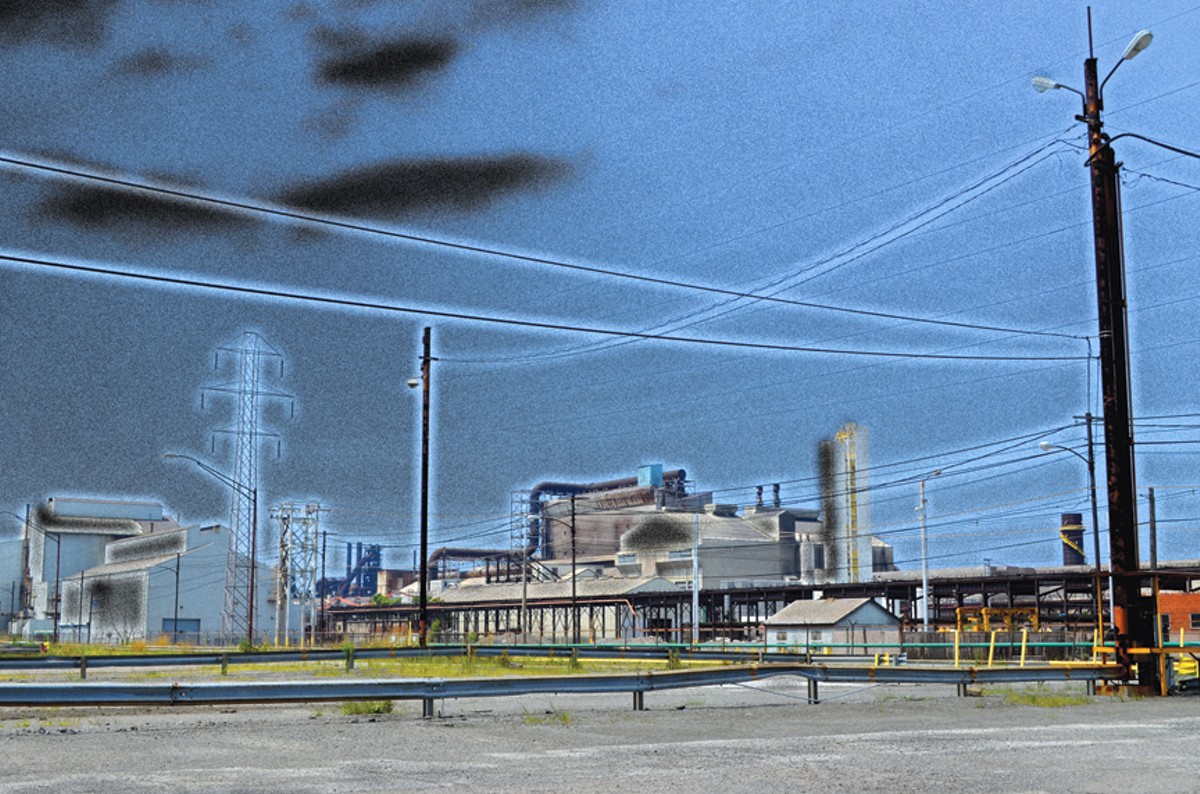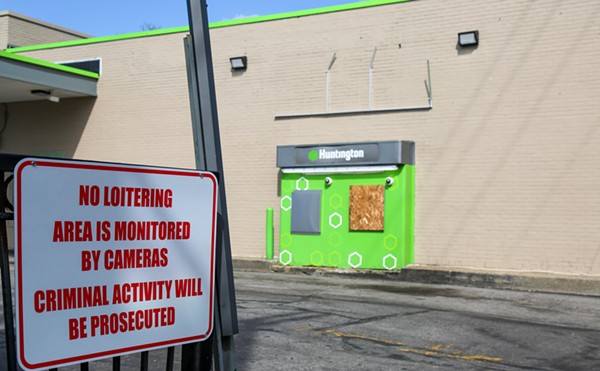Ritenauer, the captain of the ship since first being elected in 2011, sympathizes. Still, his hand is forced.
"When there are scraps on the table in terms of dollars, everybody's fighting," Ritenauer says. "There's a lot of blame. There's a lot of naturally guarded approaches to problems. It's tough to continue to engender a spirit of trust and collaboration when everybody's looking at it as their own department. You get that in every budget cycle, but when there's that [little amount of] money, it's really ratcheted up."
***
Looking ahead, the chess moves between now and next year's budget negotiations must be more conciliatory, Ritenauer says. "Revenues are back on table. With what we've gone through at the beginning of this year, there seems to be some understanding that, look, we have to do something with revenue."
For instance, during a council meeting last week, steps were taken to switch the city from traditional garbage pickup to an automated system like most Northeast Ohio cities these days. It's a long-debated issue in the city with deeply held opinions on both sides, and it's the sort of sacred-cow arena in which Lorain leaders must contend.
"This is a fair thing to do," councilman-at-large Joseph Koziura said during the meeting. "We should have done it years ago." When the crowd booed his remarks, he replied without looking up from the microphone: "Boo yourself!" Lorain is the only city in the county still on the traditional garbage pickup method.
In retrospect, it was certainly easier to stave off tax increases (the garbage pickup will add $1.30 to property owners' $13.45 monthly bill) when the steel mills were strong. Now, however, the money is needed.
See, the steel economy shades everything in towns like Lorain (and Gary, Ind., and Pittsburgh). Union representatives estimate that there have been between four and seven jobs in Lorain depending on each steel job. When layoffs occur en masse — and in a short time period — the ripples hit hard and quick.
"All the businesses — it's just a domino effect," USW Local 1104 president Dennis Hamilton says from behind his desk, just down Broadway Avenue from City Hall. "It's the big mill, the biggest employer all of a sudden not working anymore. The side businesses hurt, because there's no business for them from the people who worked in the mill because there's no money."
Lorain is a city where the estimated median household income hovered a little above $30,000 in 2013 (almost unchanged since 2000). Median household value clocks in at $83,500, down by no more than a few thousand dollars since 2000.
With more numbers, the narrative becomes clearer: Lorain's unadjusted unemployment stands at 8.2 percent, as of July. That's down from 12.6 percent in January 2012, but up from a recent low of 5.2 percent in November 2015 — right before the storm. In Cuyahoga County, the rate clocked in at 5.5 percent in July, and national unemployment has hung around 5 percent for the past year or so.
"You have foreign imports coming in," Hamilton says, squaring the global trade winds. "And you've got product in this country. What's coming in is cheaper than what we have here. It's nearly impossible to level that playing field under current global trade framework. Let's face it: Business is like you or me. You're gonna go where it's cheaper."
In recent years, China has developed a massively efficient, subsidized steel industry that "dumps" product in other countries with low import tax rates. The U.S., with a long track record of demand, has eagerly welcomed the steel. (China's the most notable exporter among Americans, though plenty of other countries, like Brazil, Japan, South Korea, Turkey and Britain, have been feeding that demand.)
According to Thomas Gibson, president and CEO of the American Iron and Steel Institute, and Chuck Schmitt, president of SSAB Americas and chairman of the American Iron and Steel Institute's board of directors, "more than 12,000 steel jobs have been lost in the past year, as imports took a record 29 percent of the U.S. market." What's happened in Lorain is not unique to the North Shore. Last year, Vallourec Star laid off dozens of workers at its Youngstown steel mill. As imports continued to soar, overall demand for oil and gas fell. Putting it simply, domestic manufacturers — guys like Tim Blake and countless other men and women in Northeast Ohio — were caught in the middle of those forces.
In August, councilman Angel Arroyo stands outside the Republic Steel gate. Seagulls screech overhead. Now and then, a car passes along East 28th Street. This is his ward, the industrial heart of Lorain. He says it's hard to count on an eventual reopening — or anything resembling the good old days of steel in Lorain. He motions across the street to El Centro, where Victor Leandry is working on organizing a community development corporation in a city that hasn't seen an active CDC in years. That's a stark contrast to the CDC-on-every-street-corner character of Cleveland and its own neighborhoods. CDCs, it is argued in urban development rings, are valuable engines of growth that blend public and private money.
While City Hall deals with budget line items and the nuts and bolts of getting through a calendar year, others look forward and struggle to be as creative as they can be with the infrastructure and resources they have, working with the assumption that steel, if it does come back, probably will never come back at the size and scope that once buoyed the city.
"My problem as a councilperson is what can we do with this property?" Arroyo says. "It's over a century of toxic waste under the ground. It's going to be a major EPA project to clean this up if they never open again. What do we do to save our community? That's what the city really needs to start grasping: How are we going to help this area?"
***
On Sept. 7, the marquee outside the Palace Theatre, a renovated stalwart of downtown Lorain, read, "Welcome Big Ideas for Lorain." It was at once an announcement of the evening's main event — the Big Idea Meeting — and also an imperative. Welcome these big ideas. It's time to take another route.
The Department of Building, Housing and Planning is working with outside agencies to craft a vision. Think of how Lakewood, of similar population, embraced bike lanes and streetscaping to revamp Detroit Avenue. Simple amenities like that add up to big ideas and, with time, reel in the sort of active citizenry and spending that a former boomtown needs to grow anew.
The prevailing theme of the night was "the past is the past," echoing the finality with which people around town have been discussing the steel downturn and the hopefulness with which they discuss the future.
"To me, that's what the Lorain spirit is: It's getting through the tough times and working toward the goal and the vision of where we all want to go," Ritenauer said during the event. "We can all live in the past and quibble about what's happened and how we've been wronged or slighted. The bottom line is tonight is about where we're going in the future."
But all of that talk begins with ideas — big ideas.
Earlier this year, new board members revitalized the mission of the Palace Theatre, ushering in what seems to be a wholly distinct phase of the 88-year-old building and promoting shows that will draw an audience from across Northeast Ohio. (Apart from the Big Idea Meeting, recent events have included movie screenings, comedy shows and events revolving around local history.)
Down the road at Black River Landing, Rockin' on the River has brought major weekly summertime concerts to the heart of Lorain for a few years now. It's seen as a massive success in the entertainment sector of the city. That translates to revenue.
"That is, I think, the direction of Lorain," Blake says. "It's like it is in the entertainment part of Cleveland. It didn't happen overnight. They turned the manufacturing Flats into something. That could happen in Lorain eventually, and they're trying real hard to do that. I don't think that'll replace manufacturing, but it'll definitely open up — you know, we're on the lake, and it's just the very beginning of what needs to be done with the lake and the entertainment districts. It brings people out of town to Lorain."
Standing outside the Palace and taking in the Americana charm of Broadway Avenue, it's easy to supplant the doom-and-gloom headlines with a sense of reinvention and activity here in Lorain. "It's not that people don't want to be here or don't want to come here, it's a matter of how do they cash-flow it," Ritenauer says, when asked what's next for the city. Like Leandry and others working on assembling a CDC for Lorain, Ritenauer is well aware of the role that public dollars play in that reinvention. "When you look at development in major cities, there's always some type of governmental component in most cases."
Arroyo concurs, returning to the theme of Lorain's spirit being an uplifting one. "They can take the steel mills away, but they can't take away what the steel mills have done for our community. What we also need to realize is we have to start thinking more about how we're going to rebuild our community if they don't come back."
"We've been here before," Ritenaur said at the Big Idea Meeting. Steel downturns and industry-wide bankruptcies stand like landmarks in Lorain's economic history. That's the nature of the thing.
Lorain at one time was a boomtown, an industrial stronghold, surely. There were the mills, the Ford plant, the shipyards. But as if in economic retreat, the shipyards closed down, the Ford plant closed down, and now the mills are resting on the threshold of ... something.
"The mill was the last linchpin they had for their economy," Gallagher says of the city's forecasts.
The city's collective response? For now.
In 1982, Tim Blake writes a song. His lyrics resonate with his coworkers, his family. In 2016, he publishes the tune on YouTube and captures the emotions of still more generations of steel workers. The same thing is happening all over again.
For now.
Perhaps, after another 34 years of global trade, after Lorain moves on from its tether, younger generations in the city won't have a clue what Blake's sentiments mean. Perhaps they'll have set all these big ideas in motion. They'll have taken another route.
Now the iron gates are locking up and leaving town,
My last pay stub sits on the window sill,
I'm playing my guitar and working in the bar,
'Cause life goes on without the old steel mill,
I'll be getting along without making steel.















